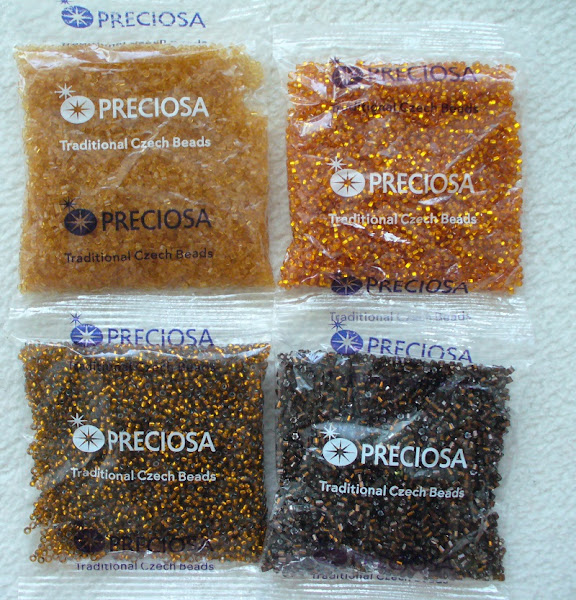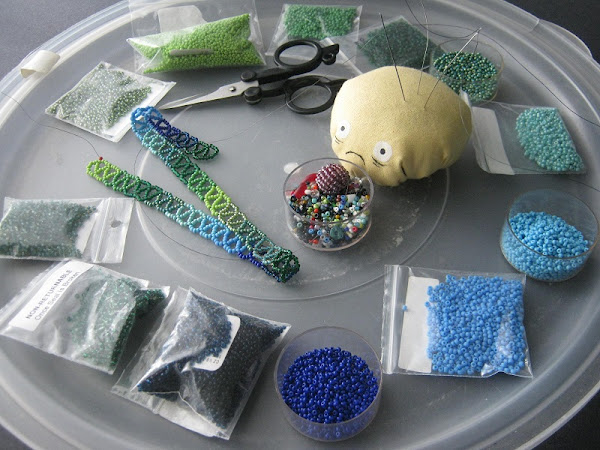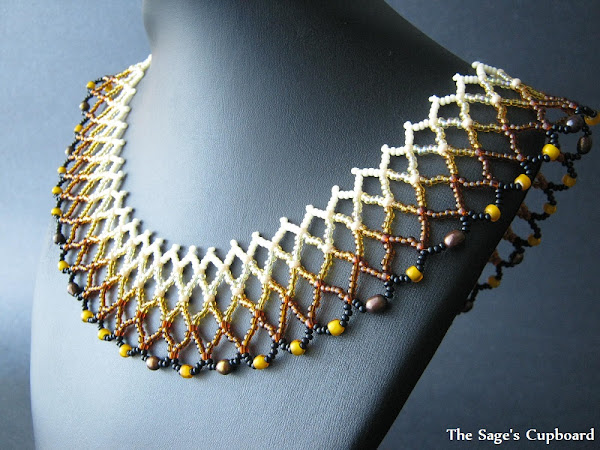
Inspirational Beading: How did you first get into jewelry design?
Jessee: I can’t remember a time when I wasn’t interested in jewelry, but I think the ancient Egyptians had a lot to do with it. From the time I was about six years old, I remember going to the library with my mom and making a beeline for the mythology section, and I was fascinated by mummies and ancient Egyptian life. Naturally, books on Egypt included lots of pictures of incredible jewelry, including beaded broad collars and mummy shrouds.
I also became interested in Native American art when I visited the Alabama-Coushatta reservation with my grandfather, where I saw a boy my own age (around 7 years old) performing a modern, powwow-style fancy dance. I was captivated by his lavish regalia, especially his blue and white feather bustles, and my first thought was “I want to make an outfit like that!” As soon as we got home from Texas, I checked out a copy of W. Ben Hunt’s The Complete How-To Book of Indiancraft,
Inspirational Beading: Do you remember your first design? Where is it today?
Jessee: The very first beaded project I remember that involved more than simple stringing was a bracelet I made for my mom out of plastic pony beads in several shades of blue. I must have been about eight at the time. I was trying to come up with a more innovative way of putting the beads together than just stringing them, so I played around with thread and two needles until I made what I now know is a bead ladder. My mom seemed delighted with it (she’s a good mom!), and for all I know, she may still have it. I’m not sure if that really counts as a “design,” but it was the first beaded thing that I remember being proud of.


The first true beadwork design that I came up with on my own was a loom-woven bracelet (my first loom-woven project) that was a variation on a Greek key pattern in black, silver, and iridescent, transparent blue and green. I made a lot of bad newbie choices (like using regular poly/cotton sewing thread and those cheap painted silver beads that lose their coating over time), but that project was enough to get me hooked. I think I still have it stashed in a box somewhere.
Inspirational Beading: Do you have a favorite kind of bead or jewelry component?
Jessee: I love (and hoard like a dragon) very tiny seed beads, size 16/o and under, many of which were made before the twentieth century. I have a good collection of 20/o seed beads, but the only finished design I’ve made with them is the Burmese Python earrings that were featured in 500 Earrings.

Jessee: A lot of my work, in both beads and other media, stems from what is known in NeoConfucian Chinese philosophy as “Li.” Li can be thought of as the underlying force that brings order and structure to nature, and it is expressed in such things as the shapes of clouds, the branching of trees, and fractal patterns. The expressions of Li that hold the most fascination for me are the spot and stripe patterns found on living things. Everyone is familiar with the beautiful spots of the big cats, but fewer people take note of the equally spectacular patterns on mollusks, reptiles, insects, or even plants. My husband is an entomologist and we work together on many research projects, so naturally a lot of inspiration comes from the endless variety of insects.
Inspirational Beading: What was the inspiration behind your favorite design?
Jessee: It would be hard to choose a single favorite beadwork design, but one of the projects that I was most satisfied with was a loom-woven panel that I made for a friend of mine based on his photograph of a ghost tiger beetle (Cicindela lepida). This little beetle (about 8 – 10 mm long) lives only on areas of white sand, emerging in the late afternoon to hunt for ants and other small prey. Its head, underside, and legs are deep copper, while the wing covers are a delicate ivory. My friend’s photo was so detailed that you could actually see the folded wings where they overlapped beneath the slightly translucent wing covers, and the sparkle from the individual grains of sand the beetle was standing on.
Capturing the effect of translucency was a challenge, and I think I used about 12 shades and finishes of white, ivory, and pale tan in the beaded panel. The sand was fun, too—I used quite a few colors there, including a transparent glass bead with tan lining for the sparkly grains. Alas, I didn’t get a photo of the panel before I gifted it to my friend! He has it hanging in his study in Edmonton, Alberta, so I’ll have to get him to take one for me.
Inspirational Beading: Is there a material or subject that you would love to work with, but haven’t tried yet?
Jessee: I work with many different media, so there’s always something new I want to try. In terms of beadwork, I tend to stick primarily to seed beads, but I would like to try new things with them. I would particularly like to try making some sculptural pieces, perhaps using welded steel frames that would allow me to make airy structures with light shining through the beaded panels. (The danger there is that they could end up just looking like fancy lampshades.) I’m also interested in the sort of 3D project that involves covering an existing object with beadwork; on a visit to Mexico City, I was lucky enough to see a VW Beetle completely covered in beadwork by Huichol artists, and it was one of the most mind-blowing things I’ve ever seen. I would love to do something that impactful someday.


Inspirational Beading: What is your favorite color to work with?
Jessee: That’s almost like choosing a favorite song—too hard to pick just one! I love all shades of green because of its connotation of life and growing things and nature, and I also like the challenge of finding good, earthy colors ranging through ivory to tan and light brown (I have a lot of use for those colors in my nature-derived designs). However, the color that makes me most cheerful is bright, bright orange. I have a few designs based on orange insects (like the Bella Moth), and for some, I even use neon orange fly-tying thread to bump up the color. My favorite color of seed beads are some bright orange transparent 14/o that I “mattified” with glass etching solution. They’re just delicious!
Inspirational Beading: Who do you hope to inspire with your work?
Jessee: I would hope that anyone could find something to relate to in my designs, but the kind of person I would really expect it to resonate with is someone who has an interest in the natural world, and who finds satisfaction in the tiny details of the world around us. I also strive to make my jewelry as well-wrought as possible, with a very solid feel, so I think that the physical connection between the wearer and the jewelry will appeal to people who enjoy craft for its own sake, and the simple pleasure of a well-made object.
You can see more of Jessee’s jewelry designs in her Etsy shop, and get the latest updates from Silverspot Metalworks on Facebook.
Copyright 2013 Inspirational Beading and Silverspot Metalworks
Subscribe to Inspirational Beading
Get inspired on Facebook and Google+
This page includes affiliate links. Actions you take can result in a commission for Inspirational Beading.



































